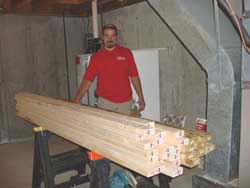 Are your garage and basement organized or full of clutter? Do you have enough shelves so everyone in the family knows where to put things and more important, where to find things when needed? Too often and especially when company is coming, people hide their clutter in the garage or basement. It's quick and you can close the door so no one sees the clutter.
Are your garage and basement organized or full of clutter? Do you have enough shelves so everyone in the family knows where to put things and more important, where to find things when needed? Too often and especially when company is coming, people hide their clutter in the garage or basement. It's quick and you can close the door so no one sees the clutter.
Guess what? Rarely does anyone remember to go back and sort out the clutter, so the piles keep growing. Even worse is when it's too difficult to find something, you go out and buy another … you can fill in the blank! Let's look at some simple shelving you can put in any basement or garage, so you can find what you need next time.
Basic Shelving You or Your Handyman Can Build
We're going to follow the story of a handyman customer who purchased a condo. The day after the closing, he and I walked through the condo and put together a list of projects he wanted done. While we were picking out new wood flooring, tile and bathroom fixtures, we started building shelving in the basement. It was perfect as we could store all the extra materials there as we completed other projects.
Our customer wanted his shelves custom built as he wanted shelves to be at least 2 feet deep and most shelving you can buy and assemble is only 18 inches deep. We used pressure treated wood on the bottom in case there were water issues and left the top shelves open to make this space easier to access, and for over sized items. My handyman technician also maximized the shelving on the condo's back wall while leaving enough space to maintain the hot water heater.
From an Empty Space to Walls of Shelving
So let's look at the steps to build these shelves, assuming you've got the tools and basic materials like nails (what you would expect a handyman to carry in their truck).
- Plan shelving on site and take measurements for shopping trip
- Pick up materials at a box store or local building supply store. For this particular trip, my technician went to Home Depot as he knew he could rip the plywood (come in 4 x 8 ft sheets) for the shelves to the sizes he needed, a big time saver and a lot less saw dust to clean up when done.
- Remembered to get pressure treated wood for the bottom layer of framing, just in case there is a water problem in the future.
- Bring materials back to the basement and set up tools
- Measure, cut and assemble shelving in place
- … Leaving top shelves open for easier access by homeowner.
For other ideas on getting organized, read Inspiration to Get Organized or to make sure you address any moisture problems first, read Bob Vila's article on Basement Storage






Leave a Reply